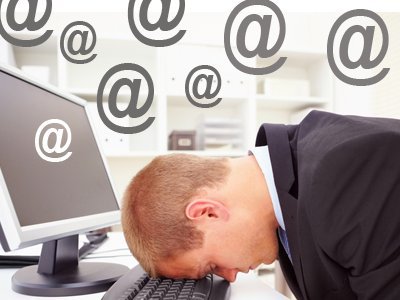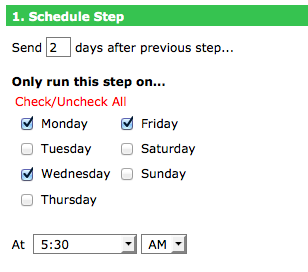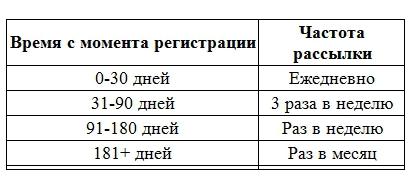E-mail marketing: about the frequency of newsletters - free of charge
- Transfer
 We continue the cycle of our publications about e-mail marketing. This time we would like to discuss the question of how frequent mailings should be in the framework of email marketing campaigns , because it has been rising quite actively recently. Jeremy Reeves, known as one of the most respected experts on marketing funnels, offers us his answer to this question.
We continue the cycle of our publications about e-mail marketing. This time we would like to discuss the question of how frequent mailings should be in the framework of email marketing campaigns , because it has been rising quite actively recently. Jeremy Reeves, known as one of the most respected experts on marketing funnels, offers us his answer to this question. So how frequent should the mailings be? Some say one thing, others say something completely different. But almost everyone with whom I had a chance to talk about this approached the question one-sidedly - and therefore gave an unambiguous answer and unambiguous recommendations on what to do.
This, as many of you might guess, is completely untrue.
As you will see, it is impossible to give a definite answer to the question posed. In this article I will talk about various aspects related to the frequency of email newsletters, how to find out which category you belong to, as well as my most successful cases on this issue for organizations from various fields of activity.
To begin with, we recognize ...
The importance of frequent emails
The following statement, from my subjective point of view, is undoubtedly true:
The more you communicate with your current and potential customers, the more you can earn.
For all the time that I am in this business — and I worked with hundreds of different organizations (from more than 40 different areas), I realized that this is 100% true.
You will ask why?
Any kind of communication - through e-mail, by phone, tête-à-tête, by writing in an envelope or somehow else - is building relationships. If you maintain frequent contacts with customers, you take into account several key factors related to business growth and show the following:
1. Make sure that you are one of the leading experts in your field.
2. Increase your self-confidence.
3. You prove that you are ready to deeply and for a long time deal with the issue (which causes even more confidence).
4. Strive to settle in the client’s head in order to prompt him to buy at the right moment.
5. Able to refute many objections, showing the benefits in time.
Here, as everywhere else: the more you communicate (in our case, by e-mail), the more money you earn.
However, before continuing, let me clarify something. More active communication does not always imply very frequent letters. In order for communication with real and potential customers to be called effective, they require that they open your email, read it, click on the link and, in the end, buy something. So, the content in the newsletter must be correct!
You have to find such a fine line, in which you communicate with users not only often, but also effectively. Excessive zeal in trying to communicate can lead to a negative result. If your audience is not clinging to what you say, then you are not saying it that way - and this will lead to a decrease in sales and, as a result, a drop in profits.
Therefore, the next question will be this.
Which is better: automatic mailing or bulk?
If you still do not understand, mass mailings are one-time. You send this letter only once, and only current subscribers receive it. Compare this with automatic newsletters, the contents of which can be prepared in advance, and then automatically send these letters as part of working with new subscribers.
So what is better?
To this, alas, there is no answer.
However, there are some guidelines to help you determine what is best for you.
Option 1: Bulk mailings - they are suitable for those who like to tell stories. In your morning letter, you can describe something that happened to you the night before. This option is suitable for people who can write and send out such messages regularly. If you feel able to write letters every day, every week, every month, and do it year after year, you will not find anything better than mass mailings.
Option 2:Automated mailings - I personally love them more, because in my case they can be adapted to almost anything and automated. Very often I find myself too busy with private clients and may forget to send something regular. By setting up a strategic mailing list, I can keep in touch for months and even years, although I really am not here. It is necessary to prepare well in advance - and that’s it.
But this is where the majority stupor happens. They are told: choose this or that, and forget about this or that. I think this is impossible.
Here's how it works for me.
This is called ...
Option 3:Hybrid system. Since I strive to automate my business in every possible way, I actively use automated mailings. However, I like to enter into direct contact and share something interesting, for example, information about a new product or small advertising, or even tell stories that cannot be automatically sent to all customers.
Maybe you have the same picture?
If so, then you can simply set up automatic mailing on certain days of the week.
Say Monday, Wednesday, Friday.

Three-time Newsletter Example with Office Autopilot
If your robot sends greetings on these days, you can leave the other four (Tuesday, Thursday, Saturday and Sunday) for mass broadcasting. You just have to try not to send two letters a day (this is not always bad, but many are against this amount).
I have been practicing this approach for many years and can only recommend it.
But we still have not answered one of the most important questions that you must have asked ...
How often do you need to send such mail?
Ask ten people and get ten different answers. You are more likely to witness a fight over this matter than peace and harmony. The fact is that the answer to this question will be different for different areas of business.
The short answer is:
Send as often as you can - but as long as you are able to communicate something valuable to your existing and potential customers each time.
And how do you guess that you have provided valuable information to them? Very simple. Pay attention to key metrics such as:
• Percentage of open emails.
• Clickability.
• Unsubscribe percentage.
• Conversion rate (via email).

An example from my automatic newsletter.
There are few clicks because in some letters there is nothing to click on.
As for the long answer ...
I found that for 99% of organizations one of three options is suitable:
1. Send letters every day.
2. Send often (1-3 times a week).
3. Send as you have to.
And here is how each of the options I can characterize:
Every day. If you want to prove that you are an expert in your field, write letters every day. If you are selling an information product, daily letters will suit you. Some organizations involved in the provision of services (such as marketing advice or financial planning) are also helpful. Daily newsletters are also good if you have a lot of different products or services. If you are able to write every day, always telling your recipients something valuable, do it. Your sales will grow literally overnight.
One to three times a week.This is best suited if you feel that you are not able to figure out what to write about every day (it is difficult only at first, and then it will go on your own), or if your potential client is an extremely busy person. Say, if you provide interior design services, writing every day may be (or may not be) too much. If you own an eCommerce store and send out ads every day, you will most likely be considered annoying. In these situations, a frequency of 1-3 times a week seems to be the best option.
Sporadicize.In some cases, daily and even just frequent messages are useless. Imagine a pool cleaner. What if he wrote you letters three times a week, and even in winter? What if your dentist wrote you every day or a couple of times a week? And the man who paints the walls of houses? And the one that deals with roof problems? What about an accountant? That would be too much. If you rarely resort to services, I would advise you to make yourself known at least once a month (a letter in the format of a newsletter, or a printed one, is best), but not more than twice a week.
Determining the right newsletter frequency that is right for your case requires a thoughtful approach and looking at yourself through the eyes of current and future customers.
How often do they want to hear about you? Often - how often is this? Am I bothering them or am I helping them? These are questions to consider.
Fortunately, I have a ready-made solution for you. This is something that I sometimes call ...
The effect of hot potatoes
Imagine that you pick up hot potatoes. Since it’s hot, you begin to transfer it from one hand to another. Gradually, the potato cools, and it is not necessary to transfer it more often.
Exactly the same thing happens when a person begins to be interested in your product or service. By directly subscribing to your newsletter, or by otherwise collecting contacts of people who agree to receive your letters, subscribers are as hot as ever (i.e. ready) for a purchase. Therefore, this same user WANTS to hear something from you immediately after subscribing and, probably, for some time - every day.
Gradually, everything cools, the desire to buy your product or service cools.
So here is what I advise.
1. Set up a personal newsletter for every day for some time. For simplicity, we put it in the first month.
2. When the first month passes, reduce the frequency, say, to three times a week for the next two months. I myself have a structure so that by this moment the client gets into my mass mailing.
3. Now they have a fourth month, and they still haven’t bought anything, so now they can write once a week. For one to three months.
4. When this time has passed, and they will still be interested, but just not enough time - reduce it now, now to two, or even once a month. Less often than once a month, I would not do.
Make a schedule so that your marketing activity depends on the time elapsed since registration. Everyone will have their own way.
Here, for example, what it might look like for you:

I have not seen anyone offer anything like this. Meanwhile, this is a great way to take into account the natural shopping cycle, because most of you think about you while potential customers are “hot”, but you need to build relationships over time, just not so actively.
But, of course, you must determine what is best for your business. Your time frame can be exactly the same as in the above table, and completely different.
What to take on a pencil
Long turned out a blog post, and you probably already feel dizzy.
Here are the main points that I recommend remembering.
1. Be proactive, use contact collection forms to increase conversion.
2. Write more often and sales will be more effective.
3. Mix automatic mailings with mass mailings - it is good in most cases.
4. Make sure that at least 80% of your letters have some value - and you will not force people to unsubscribe and begin to build relationships with them.
5. Always think about what information your potential or real customer needs so that he decides to purchase - and give him such information.
6. Do not forget to use the effect of hot potatoes, often sending letters to those who just registered and reducing their activity over time.
Disclaimer: Readers of the article who consider e-mail newsletters to be evil are invited to discuss here .
